Mills College
Mills College is a private liberal arts and sciences college in Oakland, California. Currently, Mills is an undergraduate women's college for women and gender non-binary students with graduate programs for students of all genders. Mills was founded as the Young Ladies Seminary in 1852 in Benicia, California. The school was relocated to Oakland, California, in 1871, and became the first women's college west of the Rockies. In 2014, Mills became the first single-sex college in the U.S. to adopt an admission policy explicitly welcoming transgender students.[4]
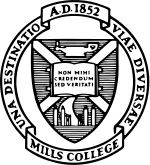 | |
| Motto | Una destinatio, viae diversae. (Latin) |
|---|---|
Motto in English | One destination, many paths. |
| Type | Private liberal arts college Women's college (undergraduate) |
| Established | 1852[1] |
| Endowment | $196.4 million (2019)[2] |
| President | Elizabeth L. Hillman (past presidents) |
Academic staff | 181[1] |
| Students | 1,122 |
| Undergraduates | 713[1] |
| Postgraduates | 409[1] |
| Location | , , United States 37°46′50″N 122°10′59″W |
| Campus | Urban, 135 acres |
| Athletics | NCAA Division III – GSAC |
| Affiliations | CLAC Oberlin Group CIC |
| Mascot | Cyclones[3] |
| Website | www |
Mills College offers more than 45 undergraduate majors and minors[5] and over 30 graduate degrees, certificates, and credentials.[6] It is home to the Mills College School of Education and the Lorry I. Lokey School of Business & Public Policy.
History
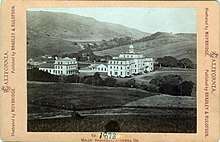
Mills College was initially founded as the Young Ladies Seminary in the city of Benicia in 1852 under the leadership of Mary Atkins, a graduate of Oberlin College. In 1865, Susan Tolman Mills, a graduate of Mount Holyoke College (then Mount Holyoke Female Seminary), and her husband, Cyrus Mills, bought the Young Ladies Seminary renaming it Mills Seminary. In 1871, the school was moved to its current location in Oakland, California. The school was incorporated in 1877 and was officially renamed Mills College in 1885. In 1890, after serving for decades as principal (under two presidents as well), Susan Mills became the president of the college and held the position for 19 years.[7] Beginning in 1906 the seminary classes were progressively eliminated. In 1920, Mills added graduate programs for women and men, granting its first master's degrees the following year.
Other notable milestones in the college's history include the presidency of renowned educator and activist Aurelia Henry Reinhardt during World War I and II, the establishment of the first laboratory school west of the Mississippi for aspiring teachers (currently known as the Mills College Children's School) in 1926, and becoming the first women's college to offer a computer science major (1974).
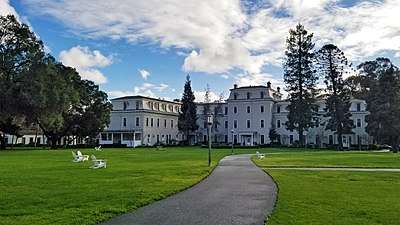
In 1990, Mills became the first and only women's college in the US to reverse a decision to go coed.[8] On May 3, 1990, Mills Trustees announced that they had voted to admit male undergraduate students to Mills.[9] This decision led to a two-week student and staff strike, accompanied by numerous displays of non-violent protests by the students.[10][11] At one point, nearly 300 students blockaded the administrative offices and boycotted classes.[12] On May 18, the Trustees met again to reconsider the decision, leading to a reversal of the vote to go coed on the undergraduate level.[13]
In 2014, Mills became the first single-sex college in the U.S. to adopt an admission policy explicitly welcoming transgender students.[14] The policy states that undergraduate students who were not assigned to the female sex at birth, but who self-identify as women, are welcome to apply for admission. Undergraduates who were assigned to the female sex at birth, but identify as transgender or gender fluid, are also welcome to apply for admission. The policy further clarifies that undergraduate students assigned to the female sex at birth who have legally become male prior to applying are not eligible for admission to Mills. The policy ends with a statement that "once admitted, any student who completes the College's graduate requirements shall be awarded a degree," indicating that once admitted to Mills, an undergraduate female student who changes sex or gender to male will be allowed to complete their degree at the college.[15]
In September 2017, Mills became the first private college in California to implement a tuition reset, substantially reducing the cost of its undergraduate education. The college reduced its undergraduate tuition by 36% (beginning in fall 2018) with a goal of making a Mills education more affordable for more students.[16] Undergraduate tuition in the 2018–2019 academic year was $28,765 (reduced from $44,765); room and board costs were $13,448. Students are still able to receive merit scholarships and need-based financial aid in addition to the tuition reduction.[17] For the 2019–2020 academic year, undergraduate tuition was $29,340; room and board costs were $13,883.[18]
Academics
Undergraduate academics
Admissions
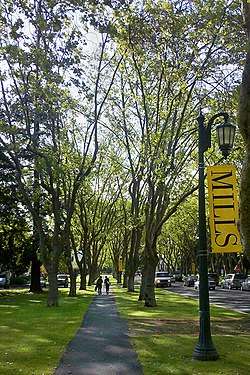
Admission to Mills is selective, but holistic. The Mills admission application process is designed to allow students to share a complete picture of their experiences, passions, activities, and what they hope to achieve, in addition to their academic accomplishments.[19]
Most first-year students admitted to Mills have a B+ average and have followed a full college-preparatory course in their secondary school, including 4 years of English, 3 to 4 years of mathematics, 2 to 4 years of foreign languages, 2 to 4 years of social sciences, and 2 to 4 years of a laboratory science. Additional course work in fine arts is given positive consideration, as are special talents or interests. Course credit may be awarded for the College Board Advanced Placement tests and the International Baccalaureate program's higher-level examinations.[20] Mills is one of nearly 200 top-tier colleges in the U.S. that have made standardized test scores (SAT or ACT) optional in the admissions process.[21][22]
Mills accepts applications from transfer students and women who have delayed their entrance to college or who wish to continue work on their bachelor's degrees. The high school transcript requirement is waived if 24 or more transferable semester units have been completed.[23] For international students, TOEFL, IELTS, or ELS are required to satisfy English language proficiency requirements. Applications should be accompanied by transcripts, a letter of recommendation, and, for international students, language test scores.[24]
An interview, either on campus or online through Skype or FaceTime, is strongly recommended for all applicants.
In 2018–19, Mills enrolled students from 41 U.S. states and 15 countries. Of the 766 undergraduate students:
- 57% identified themselves as students of color
- 51% identified themselves as LGBTQ+
- 32% were first-generation college students
- 15% were resumer students (23 years of age or older)[1]
Majors, minors, and accelerated degree programs
Mills offers more than 60 undergraduate majors and minors across the arts and sciences.[5] As of the 2017–2018 academic year, the college's top 5 majors were: English, psychology, sociology, economics, and biology.[1] To earn a Mills bachelor's degree, students complete 120 semester credits (usually 15 credits each semester). Grading is traditional, and a pass-fail option is available outside the major.[25] Mills also offers ten bachelor's-to-master's accelerated degree programs that allow students to earn a bachelor's and a master's degree in less time with the goal of increasing their career options.[26]
Core curriculum
The core curriculum at Mills is designed to develop students' analytical, communication, and critical thinking skills; encourage thoughtful creativity and innovation; and create a deep-seated respect for diversity, inclusion, and social justice. The core curriculum consists of 10 specific knowledge and skill areas organized into three outcome categories:[27]
- Foundational Skills — critical analysis, information literacy, written and oral communication, and quantitative literacy
- Modes of Inquiry — race, gender, and power; scientific inquiry; language other than English; and international perspectives
- Contributions to knowledge and society — community engaged learning and creativity, innovation, and experimentation
Students are able to tailor their completion of the core curriculum requirements to their interests by choosing from a wide range of courses that fulfill the 10 knowledge and skill areas.
Accreditation
Mills is accredited by the Western Association of Schools and Colleges (WASC).[28] The college runs on a semester system, with optional winter and summer sessions.
Graduate academics
Mills College offers 34 degrees, credentials, and certifications through their graduate programs, including the Mills College School of Education and the Lorry I. Lokey School of Business and Public Policy.[6] As of the 2018–2019 academic year, the college's top 5 graduate programs are: education, pre-medical, MBA, English, and music.[1]
Master's degrees
Master's degree options at Mills include an MBA; MFAs in studio art, book art, creative writing, and music; MAs in dance, education, English language and literatures, infant mental health, interdisciplinary computer science, and music; a master of applied economics; a master of management; and a master of public policy (MPP).[6]
Joint degrees, doctorate degrees and credentials
Mills also offers a joint MPP/MBA degree and a joint MBA/MA in educational leadership degree. The joint MPP/MBA provides graduates with the training to handle the evolving demand of professionals with cross-sector competencies who are trained in the logic of government agencies, nonprofit organizations, and social or business enterprises, as well as the intersection of these sectors.[29] The joint MBA/MA in educational leadership is specifically designed to prepare educational leaders and managers for success by giving them knowledge of the educational process and dynamics, and strategic business and management skills, to help them confront the complex challenges of the rapidly changing educational landscape.[30]
The Mills College School of Education offers a doctorate program in educational leadership and preparation for multiple- and single-subject teaching credentials, administrative services credentials, and other state-issued credentials in the field of education.[31]
Post-baccalaureate certificates
The college also offers post-baccalaureate certificate programs in pre-med, biochemistry, and computer science. These programs are designed for students who previously have earned a bachelor's degree, but are now interested in pursuing degrees or careers in fields not covered by their undergraduate degree. Graduates of Mills' Post-Baccalaureate Pre-Medical Program have an 80%+ acceptance rate to medical schools (compared to the national average of 50%).[32] Students who complete the Post-Bac Pre-Med Program and are interested in pursuing laboratory science instead of medical school can complete the biochemistry and molecular biology certificate with one additional year of course work.[33] The Post-Baccalaureate Computer Science Certificate Program has no programming or math prerequisites, allowing students to continue on to the MA in interdisciplinary computer science with an undergraduate background in a non-computer science related field.[34]
Mills graduate students have access to on-campus housing and the same campus facilities as undergraduate students, including the Betty Irene Moore Natural Sciences Building, Center for Contemporary Music, the Heller Rare Books Room, Lorry I. Lokey School of Business & Public Policy building, and the Mills College Children's School.
Faculty
Notable Mills faculty include renowned book artists Kathy Walkup and Julie Chen; choreographer and performer Molissa Fenley; experimental musicians/composers/performers Maggi Payne, Chris Brown, Fred Frith, Roscoe Mitchell; Y.A. author Kathryn Reiss; poet and editor Juliana Spahr; computer scientist Ellen Spertus; and artist/photographer Catherine Wagner.[35] Nearly 75% of Mills faculty hold the highest degrees in their field; approximately 70% are women, and over one-third are faculty of color.[36] Mills faculty from all areas of study work closely with undergraduate and graduate students, collaborating on scientific research, art preservation, academic papers, and journal articles.[37]
Financial aid
In the 2018–2019 academic year, more than 80 percent of incoming Mills students received some form of financial aid.[1] For undergraduates, the college offers a variety of merit- and need-based scholarships that can total up to $10,000 for first-year students and transfer students. Additional aid is available through federal and state grants, private scholarships, loans, and work-study opportunities.[38] For graduate students, Mills offers scholarships, assistantships, and fellowships customized to each graduate program. The college also offers access to low-interest graduate student loans from the federal government.[39]
To be considered for government aid and need-based Mills scholarships, students must file the Free Application for Federal Student Aid (FAFSA) by the appropriate deadline. California residents must also file the Cal Grant GPA Verification Form to be considered for a Cal Grant.
Tuition reduction for undergraduate students
In September 2017, Mills became the first private college in California to implement a tuition reset, substantially reducing the cost of its undergraduate education. The college reduced its undergraduate tuition by 36% (beginning in fall 2018) with a goal of making a Mills education more affordable for more students.[16] Undergraduate tuition in the 2018–2019 academic year was $28,765 (reduced from $44,765); room and board costs were $13,448. Students are still able to receive merit scholarships and need-based financial aid in addition to the tuition reduction.[17] For the 2019–2020 academic year, undergraduate tuition was $29,340; room and board costs were $13,883.[18]
Rankings
| University rankings | |
|---|---|
| National | |
| Forbes[40] | 343 |
| Regional | |
| U.S. News & World Report[41] | 5 |
| Master's University class | |
| Washington Monthly[42] | 12 |
For 2020, U.S. News & World Report ranked Mills in the following categories:
- #3 Best Value Schools
- #4 Most Innovative Schools
- #5 Best Regional Universities West (tied)
- #9 Best Undergraduate Teaching (tied)
- #11 Top Performers on Social Mobility (tied)[43]
For 2020, The Princeton Review ranked Mills in the following categories:
- The Best 385 Colleges
- Best Western Colleges
- Green Colleges
- #5 Administrators Get Low Marks
- #19 Least Religious Students
- #14 LGBTQ-Friendly
- 7 Most Liberal Students[44]
Student life
Student body demographics
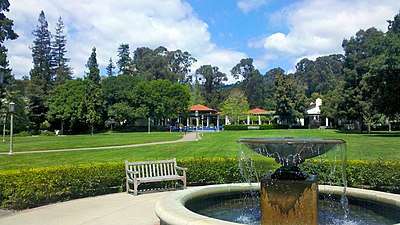
For the 2018–19 academic year, Mills student body included 1,255 students, with 766 undergraduate women and 489 graduate students of all genders. Forty-one states are represented in the student body, and international students from 15 different countries attend the college. The average class size at Mills is 16 students, with a student:faculty ratio of 11:1. The average class size at Mills is small, with 76% of Mills classes having 20 students or less.[1]
Fifty-six percent of the undergraduate students self-identify as students of color or multi-racial. Sixteen percent of the undergraduate population are "Resumer" students who are 23 years or older and returning to college. Over half of Mills Undergraduates live on-campus in any of the twelve housing options offered by the college.[1]
Forty-one percent of the graduate students self-identify as students of color or multi-racial. Of the graduate student body, eighty-six percent are full-time students. Over three-quarters of Graduate students commute to campus with only thirteen percent opting to live on-campus.[1]
Athletics
Mills College teams participate as a member of the National Collegiate Athletic Association (NCAA) Division III. The Cyclones are a member of the Association of Division III Independents.[45] Women's sports include: Cross country, Rowing, Soccer, Swimming, Tennis, and Volleyball. All students are welcome to join the sports teams. The Mills swim team was awarded the Scholar All-America Team award for swimming and diving teams who have achieved a cumulative grade point average of 3.0 or higher.[46] The athletics, physical education, and recreation facilities are housed within Haas Pavilion.
The Trefethan Aquatics Center features an Olympic-size outdoor swimming pool.[47] Trefethen is accessible to students, faculty, staff, and immediate family free of charge, and is also open for public use at a small fee.[48]
Mills maintains the Tennis Center featuring six lighted courts, which is used for recreation, events, and competitions. The tennis team also hosts a Family Day every year to promote interaction with the community.[49]
The campus houses a Fitness Center, inside Haas Pavilion, for student, faculty and staff use.[50] Athletics also maintains the Hellman Soccer Field and track, as well as Pine Top Trail which runs the circumference of campus.[51]
Student clubs and organizations
There are more than 50 student organizations at Mills run by both undergraduate and graduate students. These groups host campus-wide art exhibitions, dance performances, concerts, and lectures, as well as annual events such as Black & White Ball, Earth Day Fair, and Spring Fling.[52]
Students also participate in the Associated Students of Mills College (ASMC), an executive board of elected and appointed positions. Under the governance of a student-drafted Constitution, the board manages and disburses an annual budget that supports more than 50 student organizations, student publications, campus-wide events, and various student initiatives. ASMC is the voice of the student body to the College administration.[53]
Mills' undergraduate student publications include the Campanil, an award-winning campus newspaper and the voice of Mills students. It has won the top journalism award in its division for general newspaper excellence from the California College Media Association and has also been honored in editorial, news, entertainment and photography categories. The Crest is the Mills College yearbook which has run for 95 years. In 2010 Mills published the first annual Mills Academic Research Journal (MARJ) which focuses on research on the Mills College campus. The college also supports The Walrus Literary Journal an annual publication which includes "wonderful, whacky, weird, witty, and whimsical poetry, prose, and art from the Bay Area and beyond. Another annual literary journal on-campus is the Womanist, A Women of Color Journal which features prose, poetry, and artwork by students, alumnae, faculty, and staff of color. The publication is compiled and edited by a group of Mills students.[54]
Graduate students also create the 580 Split, an annual journal of arts and literature, publishes innovative and experimental prose, poetry, and art and was founded specifically for graduate students to participate and hone skills in editing, publishing, and creative writing. The journal has expanded its presence in the Bay Area and can be found in such well-known bookstores as City Lights. It is also one of the few literary journals carried by the Oakland Public Library.[55]
Campus
The 135-acre (0.55 km2) Mills College campus is located in the foothills of Oakland, California, on the eastern shore of the San Francisco Bay.
Campus facilities
Betty Irene Moore Natural Sciences Building
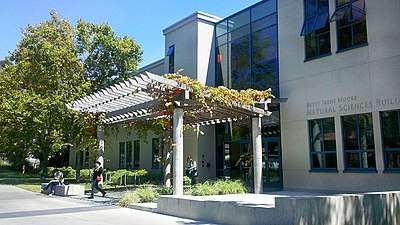
Completed in 2007, the Natural Sciences Building was the first Leadership in Energy and Environmental Design (LEED) "green" building at Mills. The facility met the most rigorous standards for materials selection, energy consumption, and water usage and was awarded platinum certification. Specifically designed to bring together the fields of biology, chemistry, physics, and psychology, Moore Natural Sciences Building encourages collaboration and research across disciplines. The building features state of the art equipment including: the Scheffler Bio-Imaging Center which contains a transilluminating fluorescence microscope with digital camera and imaging software, walk-in warm and cold rooms, and a marine culture system. The building's instrumentation includes: an atomic absorption spectrophotometer, a Fourier transform infrared spectrometer, a Fourier transform nuclear magnetic resonance spectrometer, ultraviolet-visible spectrophotometers, an electrochemistry apparatus, high-performance liquid chromatographs, gas-liquid chromatographs, and standard low-speed and high-speed ultracentrifuges as well as numerous smaller instruments[56]
The science facility offers a wide variety of classroom, laboratory, and research space equipped with up-to-date instrumentation, special outdoor teaching courtyards, and is located adjacent to the William Joseph McInnes Botanic Garden for hands-on research and study.[57]
Center for Contemporary Music
The San Francisco Tape Music Center moved to Mills Campus in 1966, became the Mills Tape Music Center, and was later renamed the Center for Contemporary Music (CCM). The CCM's archives contains over 50 years of collected recordings made at the San Francisco Tape Music Center and at Mills.[58] CCM internationally renowned as a leading center for innovation in music, and functions as an important resource center for Bay Area composers and artists.[59] Its facilities feature a 24-track recording studio, hybrid computer music studio, electronic music studio, dubbing and editing studio, technical and project development lab, Studio V, and the musicianship lab.[60]
Housed within the Mills Music Building since 1966, CCM has emphasized experimental methods in contemporary music and its allied arts and sciences. CCM maintains a variety of electronic equipment, instruments and studios, provides instruction and technical assistance, and archives audio recordings. The Center also performs a wide variety of community services in the arts, including public concerts and lecture series, informational and technical assistance, and artist residencies. Maggi Payne and Chris Brown are presently co-directors of CCM. Payne is a composer, performer, interdisciplinary artist, and recording engineer. Brown is an instrument builder, a pianist, and a composer.[61]
The music program at Mills is noted for being at the forefront of experimental music study and composition. Well-known composer Luciano Berio was on the music faculty of Mills in 1962–1964, and in 1966 Pauline Oliveros became the first director of the Tape Music Center (later the Center for Contemporary Music),[62] where she composed her electronic works "Alien Bog" and "Beautiful Soop". Morton Subotnick, later a member of the faculty, received his master's degree from Mills, studying composition with Leon Kirchner and Darius Milhaud. Laurie Anderson, Dave Brubeck, Joanna Newsom, Phil Lesh, Noah Georgeson, Holly Herndon, and Steve Reich attended the program, as well as the famous synthesizer designer Don Buchla. Terry Riley taught at Mills starting in the early 1970s. Avant-garde jazz pioneer Anthony Braxton has taught at Mills on an intermittent basis since the 1970s. Lou Harrison, Pandit Pran Nath, Iannis Xenakis, Alvin Curran, Gordon Mumma, Maggi Payne, Pauline Oliveros, Frederic Rzewski, Zeena Parkins, Fred Frith, and many others have all taught music at Mills.
F.W. Olin Library
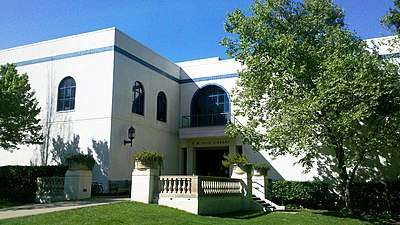
The F.W. Olin Library houses a collection of over 240,000 volumes and other media, with special emphasis on literature, history, women's studies, art and music. It also offers access to more than 60 online databases including: Academic Search, LexisNexis, PsycINFO, Sociological Abstracts, MEDLINE, ERIC, MLA Bibliography, Contemporary Women's Issues, Britannica Online, Biography Resource Center, and Science Direct, and many more. The library includes 280 study and workstations, a listening-viewing room with fully equipped audio-visual stations, and a seminar room. Open 88.5 hours a week, the library's online catalog, MINERVA, is accessible throughout the library and via the internet.[63]
The Special Collections is housed within the library in the Heller Rare Book Room and includes printed books from the 15th century to the present, as well as the Mills College Collection. Containing 12,000 volumes and 10,000 manuscripts, Special Collections features a leaf from a Gutenberg Bible and a Florentine edition of Dante's La divina commedia. It is also home to the Mills Center for the Book, a forum for cultural, literary, and aesthetic heritage of the book.[64]
Mills is also home to the Center for the Book which was established in 1989 to promote the cultural, literary, and aesthetic heritage of the book. Programs and projects encompass contemporary and historical concerns, and include the book arts, literacy, and local history. The Center for the Book involves both Mills College and the local communities, acknowledging the extraordinarily rich resources of the Bay Area.[65]
Lorry I. Lokey Graduate of Business and Public Policy Building
Completed in 2010, the Graduate School of Business building is a Gold LEED certified building. The Lokey School's focus on social responsibility leads to the cultivation of an integrative perspective across disciplines and functional areas of business and to build partnerships with organizations that share similar values.
The school's first student-run policy journal, The Policy Forum at Mills, was successfully launched in 2013, and provides a forum for policy solutions and analysis to its students, as well as allowing for discourse on published issues.[66]
Mills College Art Museum
Open to the public, the Mills College Art Museum is home to a collection of more than 8,000 works of art—the largest permanent collection of any liberal arts college on the West Coast. The collection includes old masters and modern American and European prints and drawings; Asian textiles; Japanese, Ancient American, and modern ceramics; and California regionalist paintings.[67]
Works from the permanent collection—including pieces by Pablo Picasso, Diego Rivera, Winslow Homer, Rembrandt van Rijn, Henri Matisse, and Auguste Renoir—are displayed with an ever-changing series of special exhibitions that are designed to provoke, inspire, and even amuse. Mills students have an opportunity to get involved in every aspect of the museum's work, including archival research, editing, photography, design, and installations. Undergraduates train to become curators, putting together exhibitions with art from the collection.[68] Every year art students also take on the management of the Senior and MFA exhibitions.[69][70]
Mills College Children’s School
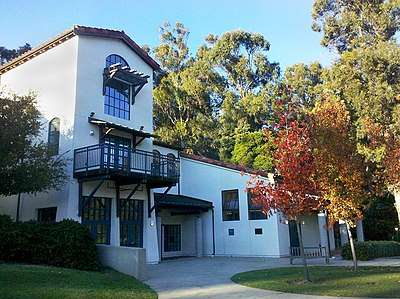
Founded in 1926 on the Mills campus, the Children's School is the oldest laboratory school west of the Mississippi River. From its inception, the Children's School has had the dual mission of providing quality education for both children and adults. A member of the East Bay Independent Schools Association, the Children's School is open to the children of Mills students, faculty, and staff as well as the general public.
Since 2000 the Children's School has been housed in the Education Complex on campus. The facility includes generous spaces for an infant/toddler program, two preschool programs, and a kindergarten through fifth grade elementary school, each with age-appropriate playgrounds and structures.
Undergraduate students majoring or minoring in child development, as well as graduate education students, have the unique opportunity of using the classroom for research and study under the guidance of master teachers with graduate degrees, professional credentials, and years of experience.
Mills College School of Education
The School of Education houses the Mills College Children's School which opened in 1926 to provide students with opportunities to learn about child behavior and cognitive development. It was the first laboratory school on the West Coast. Today, the school offers programs for infants through fifth graders, and provides Mills students with the opportunity to study progressive educational practices that focus on the whole child. In the Children's School classrooms, Mills students observe developmentally, culturally, and linguistically responsive teaching, as well as a constructivist model of classroom learning and the integration of theory and practice. The Children's School has a dual mission of providing high-quality education to the approximately 135 students in its infant, preschool, and K–5 programs, as well as offering a collaborative research setting for undergraduate and graduate education students.[71]
Programs in early childhood education, educational leadership, and teacher education are housed in the School of Education and utilize the Children's School.[72]
Campus housing
Ten on-campus living options are available at Mills, including traditional residence halls, a housing cooperative, family housing, and apartment living. Traditional-age, first-year students are introduced to the Mills community through a Themed Housing Community that is organized around a shared interest. Over the course of the fall term, faculty, students, and a specially assigned member of the Division of Student Life may attend lectures, films, museum exhibitions, or other extracurricular activities related to the central theme of their community. Transfer, resumer, graduate, and continuing Mills students reside in one of the six historic Mediterranean-inspired Residence Halls or three Craftsman-style apartment complexes.[73]
Warren Olney Hall
Named for Oakland Mayor and Mills College Trustee (1886–1921) Warren Olney,[74] Warren Olney Hall houses students of all academic levels. Built by Bakewell and Brown, a well-known architectural firm in the early 1900s, they designed the structure in a Beaux Arts Mediterranean style. The building is three-stories, wood frame, stucco exterior with a Spanish tile roof.[75] All of the rooms are either Single or Double rooms with hardwood floors and a sink, some of which feature California sleeping porches. The residence hall contains multiple common rooms, a computer lab, and full disability access.[76]
Orchard Meadow Hall
Built at the turn of the century,[77] Orchard Meadow residence hall houses mostly first-year students and consists of two separate wings, all students are housed in either Single or Double rooms with hardwood floors or carpets and a sink. Connected by a large living room with paneled oak walls and tile floors, the wings share a meeting room and a computer lab. Orchard Meadow also features multiple rooms with sleeping porches. This building also features two libraries with antique furniture and disability access. The residence hall shares a courtyard with a small reflecting pond and brick barbeque with Warren Olney.[78]
Ethel Moore Hall
Designed in a Mediterranean-style with red tile roof and blue trim, Ethel Moore Hall—which houses juniors, seniors, and graduate students. Located atop Prospect Hill, Ethel Moore was built in the late-1920s/early-1930s by Walter H Ratcliffe Jr.[79] The flagstone entrance to Ethel Moore Hall connects to a downhill path into the center of campus. Ethel Moore also opens onto the Rhododendron Courtyard which is shared with Mary Morse and accessed through the building or through a garden gate. The newly renovated Olive Courtyard is accessed through the lobby. The building contains Single and Double rooms with hardwood floors and a sink, a computer lab, and antique furnishings in the common spaces.[78]
Mary Morse Hall
Also built by Walter H Ratcliffe Jr. in 1935,[80] Mary Morse offers housing to both undergraduate and graduate students. From its location atop Prospect Hill, students look out upon the Rhododendron Courtyard shared with Ethel Moore. The building is seporated into two wings and features single or double rooms with hardwood or carpeted floors and a sink, a large stone fireplace in the living room, a community sun room, antique furnishings in the common areas, and a computer lab.[78]
Lynn Townsend White Hall
Named for former Mills College President Lynn T. White, Jr.,[81] this residence hall offers housing to both undergraduate and graduate students. The building has three wings, with an open design with modern-style furnishings and a spacious recreation room. Students have the option of living in single or double rooms (some in suites featuring one double and two single rooms) or two-bedroom suites with private bathrooms and shared kitchenette, living room, and bathroom. Each wing has its own common space in addition to the recreation room, and a computer lab is also located in the building.[78]
Campus history
Mills Hall
Mills Hall | |
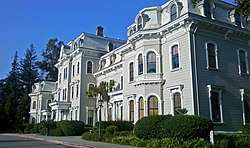 | |
| Coordinates | 37.7797°N 122.1822°W |
|---|---|
| Built | 1871 |
| Architect | S. C. Bugbee & Son |
| NRHP reference No. | 71000132[83] |
| CHISL No. | 849[82] |
| Significant dates | |
| Added to NRHP | October 14, 1971 |
| Designated CHISL | 1971[82] |
Designed in 1869 by S. C. Bugbee & Son,[84] Mills Hall became the College's new home when it moved from Benicia to Oakland in 1871. Mills Hall is "a long, four-story building with a high central observatory. The mansarded structure, which provided homes for faculty and students as well as classrooms and dining halls, long was considered the most beautiful educational building in the state".[85] Mills Hall is a California Historical Landmark[82] and is listed in the National Register of Historic Places.[85]
Julia Morgan Buildings
In 1904, Mills president Susan Mills became interested in architect Julia Morgan because she wished to further the career of a female architect, and because Morgan, just beginning her career, charged less than her male counterparts.[86]
Morgan designed six buildings for the Mills campus, including El Campanil, believed to be the first freestanding bell tower on a United States college campus.[86] Morgan's reputation grew when the tower was unscathed by the 1906 San Francisco earthquake.[86] The bells in the tower "were cast for the World's Columbian Exposition (Chicago-1893), and given to Mills by a trustee".[87] The Margaret Carnegie Library (1906), which was named after Andrew Carnegie's daughter.[86] The Ming Quong Home for Chinese girls, built in 1924 and purchased by Mills in 1936, which was renamed Alderwood Hall[87] and now houses the Julia Morgan School for Girls[86] (independent of the College). She designed the Student Union in 1916.[86] Kapiolani Cottage, which has served as an infirmary, faculty housing, and administration offices.[86][87] And finally, Mills's original gymnasium and pool, which have been replaced by the Tea Shop and Suzanne Adams Plaza.[86]
Art museum
Open to the public, the Mills College Art Museum is home to a collection of more than 8,000 works of art—the largest permanent collection of any liberal arts college on the West Coast. The collection includes old masters and modern American and European prints and drawings; Asian textiles; Japanese, Ancient American, and modern ceramics; and California regionalist paintings. In 2005, Dr. William K. Ehrenfeld donated a collection of more than 800 pieces of African art, primarily from West Africa with an emphasis on art of the Yoruba.
Works from the permanent collection—including pieces by Pablo Picasso, Diego Rivera, Winslow Homer, Rembrandt van Rijn, Henri Matisse, and Auguste Renoir—are displayed with an ever-changing series of special exhibitions that are designed to provoke, inspire, and even amuse. Students have an opportunity to get involved in every aspect of the museum's work: archival research, editing, photography, design, and installations. Undergraduates train to become curators and put together over six exhibitions with art from the collection. Every year art students also take on the management of the Senior and MFA exhibitions.
Natural Sciences Building
In spring 2007, Mills will open its new 26,000-square-foot (2,400 m2) Natural Sciences Building. The facility features four new teaching laboratories, five new classrooms, a computer room for students, and centralized science faculty offices. Up-to-date instrumentation and leading-edge computing resources will support the academic programs. The addition will become the first building on the Mills campus to meet rigorous national standards as a Leadership in Energy and Environmental Design (LEED) “green building.”
Children's School
Founded in 1926 on the Mills College campus, the Children's School is the oldest laboratory school west of the Mississippi River. From its inception, the School has had the dual mission of providing quality education for both children and adults. A member of the East Bay Independent Schools Association, the Children's School is open to the children of Mills students, faculty, and staff as well as the general public.
Since 2000 the Children's School has been housed in the Education Complex of the campus. The state-of-the-art facility includes an infant/toddler program, two preschool programs offering several scheduling options, and a kindergarten through fifth grade elementary school, each with age-appropriate playgrounds and structures.
Undergraduate students majoring or minoring in child development, as well as graduate education students, have the unique opportunity of using the classroom for research and study under the guidance of master teachers with graduate degrees, professional credentials, and years of experience.
Also housed on campus are the English First International Language School, a Greek theatre, and many other attractions. Its main route of entry, Richards Road, is included in The 100 Most Beautiful Streets of America.
Notable people
See also
References
- Horowitz, Helen Lefkowitz. Alma Mater: Design and Experience in the Women's Colleges from Their Nineteenth-Century Beginnings to the 1930s. Amherst: University of Massachusetts Press, 1993 (2nd edition).
Footnotes
- "Facts About Mills College". Mills College official website. Retrieved June 29, 2019.
- As of June 30, 2019. "U.S. and Canadian 2019 NTSE Participating Institutions Listed by Fiscal Year 2019 Endowment Market Value, and Percentage Change in Market Value from FY18 to FY19 (Revised)". National Association of College and University Business Officers and TIAA. Retrieved April 22, 2020.
- "Mills College Cyclones website". Mills College Athletics & Recreation Department. Retrieved 31 March 2018.
- "Calif. Women's College Makes Trans-Inclusive History". Advocate.com. 27 August 2014. Retrieved 31 March 2018.
- "Mills College Majors & Minors". Mills College. Retrieved 21 February 2020.
- "Mills College Graduate Programs". Retrieved 21 February 2020.
- "Susan Lincoln Tolman Mills". Encyclopædia Britannica Online.
- Bishop, Katherine (1990-05-19). "Women's College Rescinds Its Decision to Admit Men". nytimes.com.com. Retrieved 2010-05-12.
- "Venerable School for Women Is Going Co-ed". nytimes.com.com. 1990-05-04.
- "Mills Students Protesting Admission of Men". nytimes.com.com. 1990-05-05.
- Bishop, Katherine (1990-05-06). "Disbelieving and Defiant, Students Vow: No Men". nytimes.com.com.
- "Protest Continues at College Over Decision to Admit Men". nytimes.com.com. 1990-05-08.
- "College to Reconsider Decision to Admit Men". nytimes.com.com. 1990-05-12.
- "Calif. Women's College Makes Trans-Inclusive History". Advocate.com. 27 August 2014. Retrieved 14 November 2017.
- "Mills College Undergraduate Admission Policy for Transgender or Gender-Questioning Applicants". Mills College. Retrieved 21 February 2020.
- "Tuition Resets & the Redistribution of Income". Forbes. 22 March 2018. Retrieved 19 April 2018.
- "Mills Unveils Tuition Reset, Reducing Tuition by 36 Percent". Mills College. 15 September 2018. Retrieved 19 April 2018.
- "Mills Undergraduate Tuition & Fees". Mills College. Retrieved 21 February 2020.
- "How to Apply to Mills College (Undergraduates)". Mills College. Retrieved 19 April 2018.
- "First-Year Students: How to Apply to Mills (FAQs)". Mills College. Retrieved 19 April 2018.
- "Mills College Test-Optional Policy & FAQs". Mills College. Retrieved 26 November 2018.
- "Mills College Announces New Admission Policy and College Pathway Partnership". Mills College. 20 January 2016. Retrieved 19 April 2018.
- "Transfer Students: How to Apply to Mills College". Mills College. Retrieved 19 April 2018.
- "International Students: How to Apply to Mills College (Application Requirements)". Mills College. Retrieved 19 April 2018.
- "Academic Requirements - Mills College 2018-19 Undergraduate Catalog". Mills College. Retrieved 19 April 2018.
- "Mills College Bachelor's-to-Master's Accelerated Degree Programs". Mills College. Retrieved 31 March 2018.
- "Mills College Core Curriculum". Mills College. Retrieved 19 April 2018.
- "Statement of Accreditation Status: Mills College". WASC Senior College and University Commission. Retrieved 31 March 2018.
- "Mills College Joint MPP/MBA Degree Program". Mills College. Retrieved 26 November 2018.
- "Mills College Joint MBA/MA in Educational Leadership". Mills College. Retrieved 14 November 2017.
- "Mills College School of Education". Retrieved 2 April 2018.
- "Medical School Acceptance Rates of Mills Post-Bac Pre-Med Graduates". Mills College. Retrieved 2 April 2018.
- "Mills Post-Bac Pre-Med and Biochemistry/Molecular Biology Certificates". Mills College. Retrieved 2 April 2018.
- "Mills Post-Bac Computer Science Certificates". Mills College. Retrieved 26 November 2018.
- "Mills College Faculty Roster". Mills College. Retrieved 19 April 2018.
- "Facts About Mills". Mills College. Retrieved 26 November 2018.
- "Mills Student & Faculty Collaborations". Mills College. Retrieved 19 April 2018.
- "Undergraduate Cost & Aid (Mills College)". Mills College. Retrieved 26 November 2018.
- "Graduate School Costs & Financial Aid (Mills College)". Mills College. Retrieved 26 November 2018.
- "America's Top Colleges 2019". Forbes. Retrieved August 15, 2019.
- "Best Colleges 2020: Regional Universities Rankings". U.S. News & World Report. Retrieved September 8, 2019.
- "2019 Rankings -- Masters Universities". Washington Monthly. Retrieved September 8, 2019.
- "Mills College Rankings by U.S. News & World Report". U.S. News & World Report. Retrieved 23 February 2020.
- "Mills College Rankings by The Princeton Review". Retrieved 23 February 2020.
- "NCAA Members by Division". Archived from the original on 2009-03-31. Retrieved 2012-02-29.
- "Mills College Cyclones Earn Highest GPA Among College Swimming Coaches Association of America Teams". mills.edu/news. Mills College. Retrieved 22 August 2017.
- "Trefethan Aquatics Center". mills.edu. Mills College.
- "Pool Schedule and Policies". mills.edu. Mills College. Retrieved 22 August 2017.
- "Tennis Center". mills.edu. Mills.edu. Retrieved 21 September 2015.
- "Fitness Center". mills.edu. Mills College. Retrieved 21 September 2015.
- "Soccer Field". mills.edu. Mills College.
- "Student Activities". mills.edu. Mills College. Retrieved 22 August 2017.
- "Student Government". mills.edu. Mills College. Retrieved 22 August 2017.
- "Student Publications". mills.edu. Mills College. Retrieved 22 August 2017.
- "Student Publications". mills.edu. Mills College.
- "Pre-Med Facilities". mills.edu. Mills College. Retrieved 22 August 2017.
- "Natural Sciences Facilities". mills.edu. Mills College. Retrieved 22 August 2017.
- "Center for Contemporary Music Archives". mills.edu. Mills College. Retrieved 22 August 2017.
- "Center for Contemporary Music Index". mills.edu. Mills College. Retrieved 22 August 2017.
- "Center for Contemporary Music Facilities". mills.edu. Mills College. Retrieved 22 August 2017.
- Holmes, Thomas B.; Holmes, Thom (2002). Electronic and experimental music: pioneers in technology and composition (2 ed.). Psychology Press. p. 192. ISBN 0-415-93644-6.
- Bernstein, David W. (2008). The San Francisco Tape Music Center: 1960s counterculture and the avant-garde. University of California Press. p. 34. ISBN 0-520-24892-9.
- "F.W. Olin Library at Mills College". Mills College. Retrieved 2 April 2018.
- "Special Collections and Archives". Mills College. Retrieved 2 April 2018.
- "Center for the Book". Mills College. Retrieved 22 August 2017.
- "The Policy Forum". The Policy Forum. Retrieved 14 November 2017.
- "About Mills College Art Museum: Mission & History". Retrieved 26 November 2018.
- "Work-Study Opportunities at the Mills College Art Museum for Mills Students". Retrieved 26 November 2019.
- "2017 Mills College Senior Thesis Exhibition Press Release" (PDF). 23 February 2017.
- "12 Degrees: 2017 Mills College MFA Exhibition" (PDF). 22 March 2017.
- "Mills College Children's School". mills.edu. Mills College. Retrieved 21 February 2020.
- "Mills College Graduate Education Programs". mills.edu. Mills College. Retrieved 21 February 2020.
- "Mills College Housing". Retrieved 21 February 2020.
- "Warren Olney". localwiki.org. Retrieved 22 September 2015.
- "Earthquake Retrofit Program". Earthquakeretrofit.org. Earthquake Engineering Research Institute. Retrieved 22 September 2015.
- "Mills College Residential Optiona". mills.edu. Mills College. Retrieved 22 August 2017.
- "Guide to the Aurelia Henry Reinhardt Papers, 1877-1948". oac.cdlib.org. California Digital Library. Retrieved 22 September 2015.
- "Mills College Residential Options". mills.edu. Mills College. Retrieved 22 August 2017.
- "Maps of Mills Campus". djjr-courses.wikidot.com. Retrieved 22 September 2015.
- "Berkeley Daily Gazette Dec 5, 1934". Google Books. Berkeley Daily Gazette. Retrieved 22 September 2015.
- "Lynn White" (PDF). michaelpnelson.com. Retrieved 22 September 2015.
- "Mills Hall". Office of Historic Preservation, California State Parks. Retrieved 2012-03-30.
- "National Register Information System". National Register of Historic Places. National Park Service. March 13, 2009. Retrieved September 14, 2012.
- Thompson, Daniella (2006-11-17). "East Bay Then and Now: This West Berkeley Landmark Is a Proud Survivor". The Berkeley Daily Planet. Retrieved 2008-02-27.
- "CERES: State Historical Landmarks for Alameda County". Retrieved 2008-02-28.
- Ito, Susan (Winter 2004). "Julia Morgan at Mills" (PDF). Mills Quarterly. Mills College. p. 14. Retrieved 2008-02-27.
- Mills College 2007/2008 Undergraduate Student Handbook (PDF). School Datebooks. 2007. Retrieved 2008-02-27.
External links
| Wikimedia Commons has media related to Mills College. |
- Official website
- Photographs of Mills College, ca. 1940, The Bancroft Library